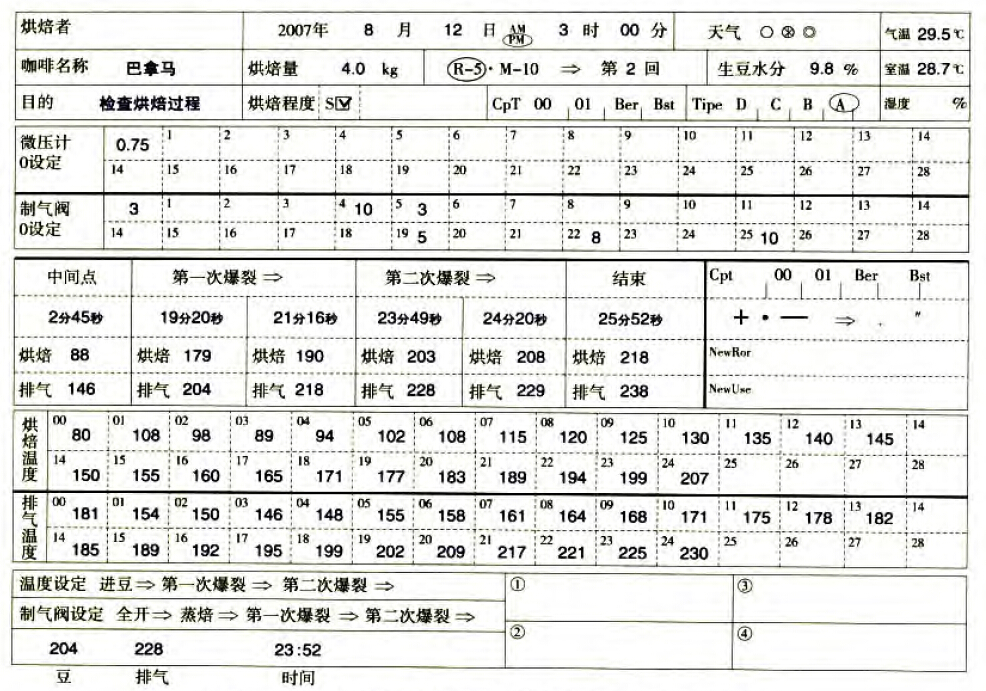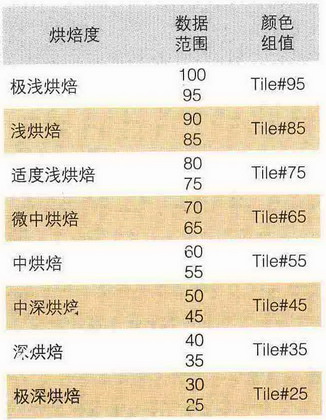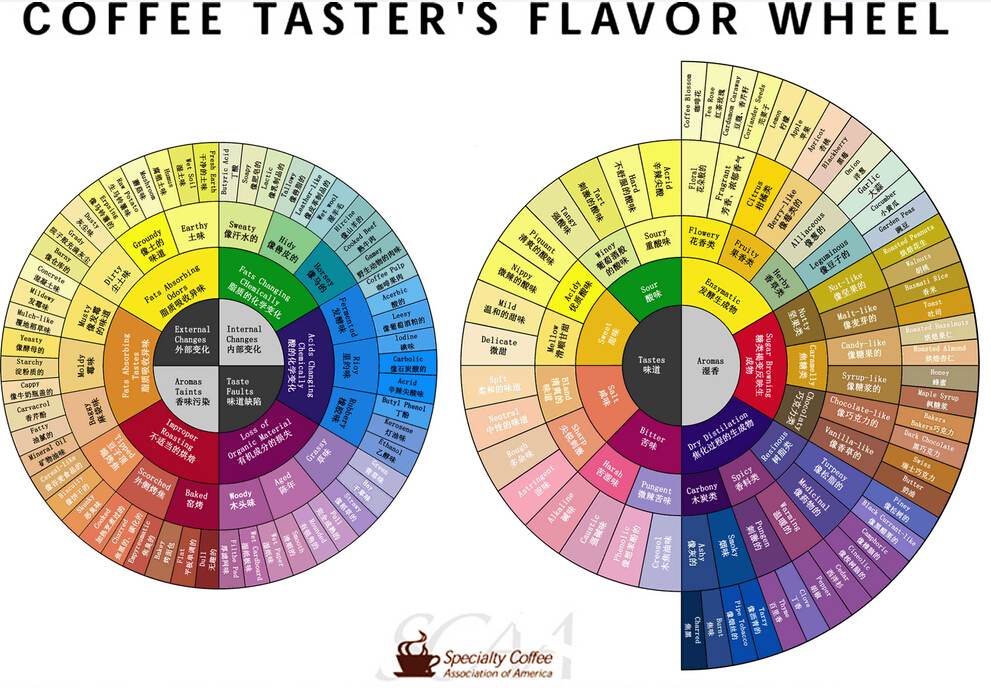Testing methods and advantages and disadvantages of all kinds of coffee cups
The significance of cup test is to evaluate and compare several different kinds of coffee at the same level. It is also an important course in coffee training and barista training.
A cup test (Cup Testing) used to finally confirm the taste of coffee
No matter how well one speaks or how skilled he is, the most important thing is the taste of the coffee in the cup. If the coffee tastes pretty bad, then theory and technology are empty talk.
The final procedure for confirming the taste of coffee is called a "cup test", but this procedure is not just a random try. The subjective judgment and feeling of "this cup of coffee is too sour" can make people confused and can't make people think about how to improve roasting.
Why does it produce a strong sour taste? To find out the cause directly, you must start from the first step of the baking process, where you can see the importance of the baking record card (schedule 1). If there is no baking record, even if the ideal work is baked, there is no reference basis for baking the same thing next time; in addition, there is no objective basis for where to make what change and how to change.

Schedule 1 5 kg baking record card of Fuji Royal Roaster (Panama)
The cadets of Paradise barista training often ask questions about raw beans. Here, Mr. Hu will attach a baking record card for both raw and roasted beans, as well as a cup test record card. in this way, you can see at a glance what the problem is. This is why the cup test needs to be matched with the baking record card.
All kinds of cup measurement methods
"Cup Test" (Cup Testing. Or Cupping, Tasting, Cup Tasting, etc.) there are a variety of methods, because there are no unified rules in the world, so the producing country, consumer country, enterprise or individual can choose the appropriate cup testing method according to their own situation. But generally speaking, the approach is derived from the "Brazilian style".
So, what is the Brazilian cup test? Next, Baitianhui Coffee School will introduce the Brazilian cup test to you.
a. Brazilian cup method
First of all, grind the roasted coffee moderately, put 10 grams into the cup and inject 150 milliliters of hot water. The roasting degree of coffee is about 65% of the value of "caramelization tester" (Agtron, schedule 2), which is about the degree of "cinnamon roasting" (light to moderate roasting in the United States). "Agtron" is the baking degree index mainly used in the United States, which is measured by a special colorimeter.
Then, stir the coffee powder soaked in hot water with a spoon to smell the fragrance. The next step is to remove the foam and scoop a spoonful of coffee liquid into the mouth with a test spoon. To confirm the defects of the coffee liquid, suck the liquid into the upper jaw and let the coffee liquid spread out in a fog in the mouth. It's not very elegant, but it confirms the smell.
Coffee is graded according to this series of sensory reviews, based on "Soft", "Hard" and "iodine". "mild" refers to the soft and elegant sour taste and strong mellow, "difficult" refers to the astringent taste like persimmon, "iodine taste" is the taste of carbonic acid and so on.

Schedule 2 distinguishes the baking degree according to SCAA's "Agrton" method
The above is a sensory review of the Brazilian cup test, but it has become unpopular recently because consumer countries (especially the United States) believe that "Brazilian evaluation criteria do not know the flavor characteristics and advantages associated with the taste of coffee."
Brazil is not ignorant of the comments of consumer countries, they also have something to say. The reason is that the main purpose of the cup test in Brazil is to find out the defective taste, not to evaluate the personality and advantages of coffee. The way of identifying defects by Brazilian cup test and grading is called "negative cup test" (Negative Testing); on the contrary, the way of positively evaluating the characteristics and personality of coffee is called "positive cup test" (Positive Testing).
Each of the two methods has its own purpose and use, but today is the era of high-quality high-quality coffee. In the past, the negative evaluation of looking for defects has been meaningless, instead, the positive evaluation of coffee personality and aroma is the mainstream of the times.
The United States, the largest importer of Brazilian coffee, has changed its evaluation method from "negative cup test" to "positive cup test", and Brazil and Brazil have been forced to significantly revise their evaluation benchmark. Brazil, which originally used the most common commercial coffee as the main force of the international market, finally spread the evaluation method of "Cup of Excellence (COE)" to the world through Brazilian production enterprises after several failed experiments. Thus it can be seen that the "positive cup test" method has really become the mainstream.
Brazilian sensory examination is generally applicable to most consumer countries in the world. The baking degree used in the cup test is set to "cinnamon baking" because it does predict the taste change between shallow baking and deep baking. With the deeper the roasting degree of coffee, the more volatile ingredients, the taste will change, so choose the roasting degree before volatilization, that is, shallow roasting to measure the cup.
In fact, there is another reason. The largest importer of Brazilian coffee is the United States. The United States entered the 1980s with light roasting, the heyday of American coffee. It is only natural that Brazil, the producer, will match the American habit of using shallow baking during cup testing. If the baking method in the United States was deeper at that time, then the Brazilian cup would have been baked more deeply.
But Paradise Coffee School believes that it is quite risky to change coffee suitable for light or cinnamon roasting to French or Italian roasting and add it to the menu. Because even if the taste is excellent after light roasting, it does not mean that the coffee is suitable for deep roasting.
Therefore, the baking degree of cinnamon measured by Brazilian cup is not necessarily used in cup testing, and it is better to use deep roasting in coffee cups suitable for deep roasting.
The defective taste of raw beans can be clearly found after shallow baking. Unlike immature beans, which are as difficult to distinguish as ordinary beans once they are deeply baked, shallow baking can easily tell the difference from their appearance.

Schedule 3 coffee cup taste ring
When using raw beans for the first time, Mr. Hu of Baitianhui Coffee training suggested that first bake it in a shallow degree, then test it in a cup, and then bake it to a predetermined baking degree if it tastes good, and then test it again. Shallow baking cup test has considerable advantages, but just knowing the taste of defects does not mean that you know the taste of the whole. No matter what kind of coffee needs to be tested, it is best to bake it to the second burst period, because it will produce rich aroma and delicacy in the early stage of the second burst.
Although the aroma evaluation of SCAA (American Fine Coffee Association) uses the roasting degree of about Agtron50 (city roasting), the rich flavor of coffee will not appear until it enters the second burst period. I hope you can understand this.
The following is a comparison of cup testing methods between SCAA and Paradise Coffee training:
B.SCAA cup measuring method
Put moderately ground coffee powder (about 8 grams) in the cup and shake and smell the aroma (Fragrance). Pour 150 milliliters of hot water and boil for 3 minutes. Cut open the dome-shaped layer of coffee powder with a spoon. Now put your nose close to the cup and smell the freshly brewed coffee (Aroma).
Next, use a spoon to remove the foam from the upper layer of the coffee liquid, rest for a while, then scoop a spoonful of the coffee liquid with a spoon, and inhale the coffee into the mouth, leaving the coffee liquid in a fog in the mouth. Confirm the aroma and spit out the coffee liquid. Evaluate the taste of coffee when it is slightly hot, cold and cooled in order, and the items to be evaluated are as follows:
Dry aroma Fragrance (aroma of coffee powder)
Wet aroma Aroma (aroma of coffee liquid)
Sweet Sweetness
Refreshing sour Acidity
Flavor Flavor
c. Baitianhui barista training recommends coffee cup test method
Prepare for moderate grinding of 10 grams of coffee powder, about 85 ℃ of hot water 150ml, to the general filter paper trickling filtration method to make one-person coffee, the extracted coffee liquid into the cup, test spoon cup test, after the test, the coffee liquid is discarded, although the next cup test is not much different, it can still be seen that the unique coffee cup testing method of Paradise Coffee training is different from that of Brazilian type or SCAA type. The main differences are as follows:
1. The baking degree is above the second bursting.
two。 Use of extraction apparatus
3. Confirm the number of projects
The Brazilian cup test is to test the coffee containing defective beans and then judge whether it belongs to the scope of export. However, the coffee cup test method used in Baitianhui coffee training has been selected by hand from the very beginning, so the taste of defective beans will not be tested, so the cup test items are less.
Compared with the confirmation of defective taste, our main focus should be on the balance of taste, which is of more practical significance for opening a shop, plus there is no need for any special equipment or equipment, and cup testing can be carried out anytime and anywhere. This is also where the coffee cup testing method of Baitian coffee training is better than other kinds of cup testing methods. The most important thing is that the cup test can be carried out continuously, so convenience is very important.
In the coffee cup test method used by Baitianhui Coffee School, the following items are something beginners must learn to judge.
Bitter taste
Sour taste
sugariness
Astringent taste
Flavor
Concentration
"Flavor" can also be expressed as "fragrance". Flavor mainly refers to the taste when it is contained in the mouth. The smell smelled by the nose is obviously different from that contained in the mouth.
When it comes to "concentration", it may be a little difficult to understand. in fact, the same amount of coffee liquid extracted with the same amount of coffee powder will have a strong or light taste.
One of the items evaluated in the SCAA cup test is the "alcohol thickness" (Body), which is tested by instantly slipping the coffee through the mouth and judging its touch in the mouth. The "concentration" mentioned here is something deeper, because the taste, such as thickness or viscosity, all comes from the fat, fiber and protein contained in the coffee liquid, which is less melted with the human coffee liquor. the coffee will be light.
Compared with the three cup measuring methods, the most significant difference lies in the "use of extraction apparatus".
Both Brazilian and SCAA cup tests only pour hot water into coffee powder without using special tools. This is to cooperate with most companies and consumers, but although this way can confirm the various flavors and aromas contained in coffee powder, the balance of taste is not known.
Baitianhui Coffee training School has been studying and working hard to choose the cup test method that is closest to the customer level as far as possible. If the cup test is different from the way customers usually drink coffee, we can't explain to customers that "this kind of coffee will taste like this again when it's roasted like this." Small-scale coffee shops with limited customers are more suitable for cup testing with daily utensils and methods.
Important Notice :
前街咖啡 FrontStreet Coffee has moved to new addredd:
FrontStreet Coffee Address: 315,Donghua East Road,GuangZhou
Tel:020 38364473
- Prev

Introduction to Coffee Cup Test what do you need to prepare before the cup test?
Coffee cup testing is not only a professional skill, a profession, but also a pleasure, so we can do it at work, in class, in formal activities, at home, on leisurely occasions, or communicate with friends. During the cup test, the cup tester (cup tester, cup tester) should smell the dry aroma of the coffee, break the residue with the cup spoon, release the wet fragrance of the coffee in the cup, suck the coffee liquid, and let the coffee.
- Next

Introduction to SCAA Standard Coffee Cup testing equipment
Description of ① cups and bowls: SCAA recommended cups are toughened glass or porcelain cups with a capacity of 207-266ml and 76-89mm lids of any material. All utensils should be clean, odorless, the same specifications and materials (for example, glass and porcelain bowls cannot be mixed with different capacities) [cup test sample preparation] bake 1.
Related
- Detailed explanation of Jadeite planting Land in Panamanian Jadeite Manor introduction to the grading system of Jadeite competitive bidding, Red bid, Green bid and Rose Summer
- Story of Coffee planting in Brenka region of Costa Rica Stonehenge Manor anaerobic heavy honey treatment of flavor mouth
- What's on the barrel of Blue Mountain Coffee beans?
- Can American coffee also pull flowers? How to use hot American style to pull out a good-looking pattern?
- Can you make a cold extract with coffee beans? What is the right proportion for cold-extracted coffee formula?
- Indonesian PWN Gold Mandrine Coffee Origin Features Flavor How to Chong? Mandolin coffee is American.
- A brief introduction to the flavor characteristics of Brazilian yellow bourbon coffee beans
- What is the effect of different water quality on the flavor of cold-extracted coffee? What kind of water is best for brewing coffee?
- Why do you think of Rose Summer whenever you mention Panamanian coffee?
- Introduction to the characteristics of authentic blue mountain coffee bean producing areas? What is the CIB Coffee Authority in Jamaica?

